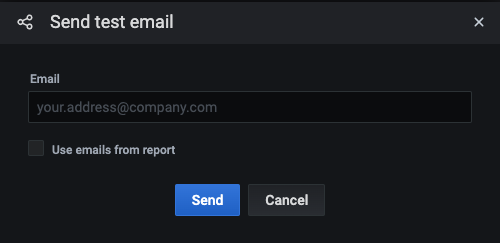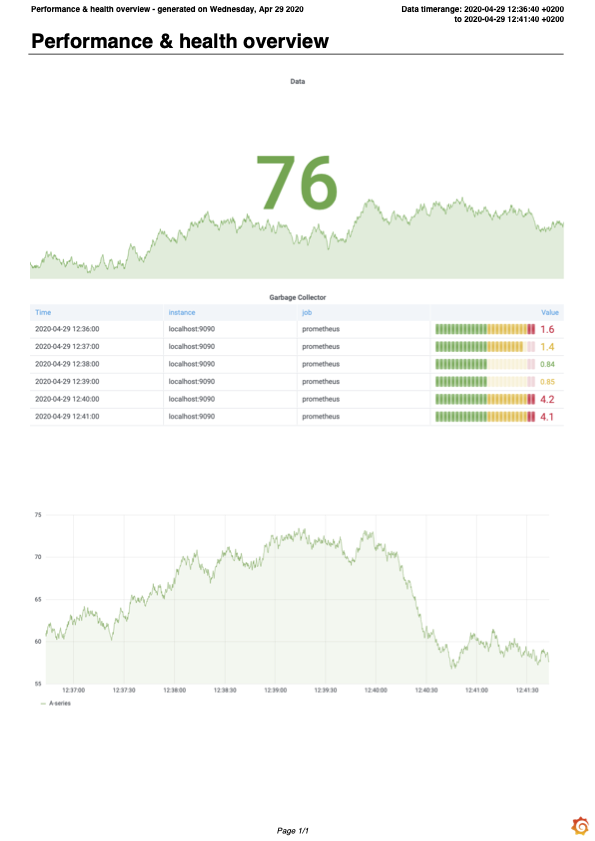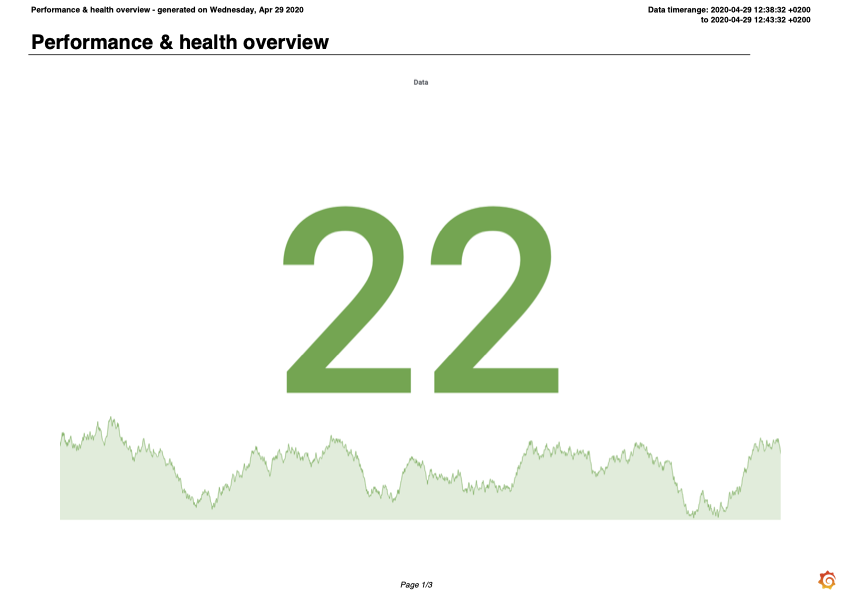Important: This documentation is about an older version. It's relevant only to the release noted, many of the features and functions have been updated or replaced. Please view the current version.
Reporting
Reporting allows you to automatically generate PDFs from any of your dashboards and have Grafana email them to interested parties on a schedule.
Only available in Grafana Enterprise v6.4+.

Any changes you make to a dashboard used in a report are reflected the next time the report is sent. For example, if you change the time range in the dashboard, then the time range in the report changes as well.
Requirements
- SMTP must be configured for reports to be sent. Refer to SMTP in Configuration for more information.
- The Image Renderer plugin must be installed or the remote rendering service must be set up. Refer to Image rendering for more information.
Create or update a report
Currently only Organization Admins can create reports.
- Click on the reports icon in the side menu. The Reports tab allows you to view, create, and update your reports.
- Enter report information. All fields are required unless otherwise indicated.
- Name - Name of the report as you want it to appear in the Reports list.
- Choose dashboard - Select the dashboard to generate the report from.
- Recipients - Enter the emails of the people or teams that you want to receive the report.
- Reply to - (optional) The address that will appear in the Reply to field of the email.
- Custom message - (optional) Message body in the email with the report.
- Preview the report to make sure it appears as you expect. Update if necessary
- Select the layout option for generated report: Portrait or Landscape.
- Enter scheduling information. Options vary depending on the frequency you select.
- Save the report.
- Send test mail after saving the report to verify that the whole configuration is working as expected.

Layout
We’re actively working on developing new report layout options. Contact us if you would like to get involved in the design process.
Scheduling
Scheduled reports can be sent on a weekly, daily, or hourly basis. You may also disable scheduling for when you either want to pause a report or send it via the API.
All scheduling indicates when the reporting service will start rendering the dashboard. It can take a few minutes to render a dashboard with a lot of panels.
Hourly
Hourly reports are generated once per hour. All fields are required.
- At minute - The number of minutes after full hour when the report should be generated.
- Time zone - Time zone to determine the offset of the full hour. Does not currently change the time in the rendered report.
Daily
Daily reports are generated once per day. All fields are required.
- Time - Time of day in 24 hours format when the report should be sent.
- Time zone - Time zone for the Time field.
Weekly
Weekly reports are generated once per week. All fields are required.
- Day - Weekday which the report should be sent on.
- Time - Time of day in 24 hours format when the report should be sent.
- Time zone - Time zone for the Time field.
Never
Only available in Grafana Enterprise v7.0+.
Reports which are scheduled to never be sent have no parameter and will not be sent to the scheduler. They may be manually generated from the Send test email prompt or via the Reporting API.
Send test mail
Only available in Grafana Enterprise v7.0+.
- In the report, click Send test mail.
- In the Email field, enter the email address or addresses that you want to test, separated by semicolon. If you want to use email addresses from the report, then select the Use emails from report check box.
- Click Send.
The last saved version of the report will be sent to selected emails. You can use this to verify emails are working and to make sure the report is generated and displayed as you expect.

Send report via the API
You can send reports programmatically with the send report endpoint in the HTTP APIs.
Rendering configuration
When generating reports, each panel renders separately before being collected in a PDF. The per panel rendering timeout and number of concurrently rendered panels can be configured.
To modify the panels’ clarity you can set a scale factor for the rendered images. A higher scale factor is more legible but will increase the file size of the generated PDF.
These options are available in the configuration file.
[reporting]
# Set timeout for each panel rendering request
rendering_timeout = 10s
# Set maximum number of concurrent calls to the rendering service
concurrent_render_limit = 4
# Set the scale factor for rendering images. 2 is enough for monitor resolutions
# 4 would be better for printed material. Setting a higher value affects performance and memory
image_scale_factor = 2Report time range
Reports use the saved time range of the dashboard. Changing the time range of the report is done by saving a modified time range to the dashboard.
The page header of the report displays the time range for the dashboard’s data queries. Dashboards set to use the browser’s time zone will use the time zone on the Grafana server.
If the time zone is set differently between your Grafana server and its remote image renderer, then the time ranges in the report might be different between the page header and the time axes in the panels. We advise always setting the time zone to UTC for dashboards when using a remote renderer to avoid this.
Troubleshoot reporting
To troubleshoot and get more log information, enable debug logging in the configuration file. Refer to Configuration for more information.
[log]
filters = report:debug




